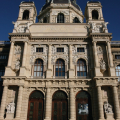VIENNA ART HISTORY MUSEUM
This art history museum, built by Semper and von Hasenauer, is one of the oldest in the world.
It's one of Vienna's jewels, and a treat for art and history lovers. The Kunsthistorisches Museum, inaugurated in 1891, was built not far from the Imperial Palace to house the vast collections - 250,000 works! - of the Habsburg family, great art collectors and generous patrons of the arts. Its architecture is inspired by the Italian Renaissance. You're not just visiting a museum, you're discovering a palace, with a sumptuous entrance hall, a central cupola - under which the café-restaurant is located - and a succession of immense rooms with very high ceilings. And it's a majestic visit that this exceptional museum invites us to make. And even when it's busy, visitors rarely feel they're "queuing up", except perhaps for a few Bruegels, the Rubens, Caravaggio's Medusa or the Madonna of Krumlov. Don't try to see everything in one visit - you'll get nothing! Devote one visit to Flemish, Dutch and German painting, another to Italian, Spanish and French painters, another to Antiquity, another to the cabinet of art and curiosities, and so on. And take time out for a coffee or pastry, or cut the day in half with a real meal in the restaurant under the dome.
With its countless masterpieces, including the world's largest Bruegel collection, the Kunsthistorisches Museum is one of the world's leading museums. Its long gallery of paintings, divided into several rooms, houses major works of Western pictorial art. These include Raphael's Madonna in the Greenery, Vermeer'sArs pictoria, Velázquez's portraits of infantes and masterpieces by Rubens, Rembrandt, Dürer, Titian and Tintoretto. In another register, the ancient and Egyptian-Oriental collection fascinates and raises questions about ancient civilizations and their habits and customs. The museum is a major attraction in Vienna. It attracts many tourists and enthusiasts of classical painting from the 15th to 17th centuries. The museum's collection of antique sculptures is an outstanding complement to its artistic offerings.
Entresol. The Egyptian and Oriental collection occupies some ten rooms, with a succession of extremely important pieces such as the tomb of Thoutmôsis III or that of Prince Ka-ni-nisut, numerous sarcophagi, examples of the Book of the Dead... The collection comprises 17,000 pieces covering a period of 4,000 years BC. The next 16 rooms are dedicated to Greek and Roman antiquities. Nearly 2,500 objects spanning three millennia are on permanent display. Some of the Roman pieces come from excavations carried out on Austrian territory, notably in Vienna. Don't miss the unique collection of antique cameos, including the gemma augustea; the Nagyszentmiklos treasure; and the collection of antique vases, including the Brygos cup.
This isfollowed by the 20-room Kunstkammer , featuring rare items from the Cabinet of Curiosities and the Habsburg Treasury. Precious objects from the Middle Ages, Renaissance and Baroque are on display. During the Renaissance, emperors and archdukes collected rare and unusual objects in an encyclopedic spirit. Ostrich eggs, precious stones, coral and shark's teeth were transformed into jewels or extraordinary objects by artists who also worked on the magnificence of everyday objects. Admire the Saliera (16th century), Cellini's precious solid-gold salt cellar, Maria Theresa's breakfast set, the lapis lazuli dragon cup, drinking games and more. Surprise after surprise...
1st floor. Dedicated to painting. On the left, the Italian, Spanish and French schools; on the right, the Flemish, Dutch and German schools. Both collections are the result of patronage and purchases of paintings by the Habsburgs over the centuries. Works from the 16th and 17th centuries form the basis of the collection, with paintings by Raphael, Caravaggio, Titian, Tintoretto and Veronese for the Italians; Bruegel the Elder, Rembrandt, van Eyck, van der Weyden, Vermeer de Delft, van Dyck and Rubens illustrate the Flemish and Dutch Middle Ages and Renaissance; germany is represented with masterpieces by Albrecht Dürer and Lucas Cranach; finally, the Spanish branch of the Habsburgs has made it possible to bring together a number of Velázquez portraits.
2nd floor: numismatic collections of 700,000 items covering three millennia, coins, medals, banknotes..
Temporary exhibitions are always very attractive, and sometimes justify a visit to Vienna on their own. After the magnificent exhibition dedicated to Titian and his vision of women scheduled for 2021, in 2022 the museum presented Iron men, an astonishing exhibition on steel in fashion from defensive armor onwards, before returning at the end of 2022 to Titian and his Christ Savior of the World or Christ on the Globe. After Raphael in 2023, the Kunsthistorisches Museum's major autumn exhibition is dedicated to Rembrandt-Hoogstraten (October 8, 2024 - January 12, 2025).
The store on the first floor features a wide range of art objects and books.














Attention : peu d'explications en anglais (affichettes en allemand et seulement quelques plaques en anglais).
Expo temporaire en supplément du prix d'entrée.